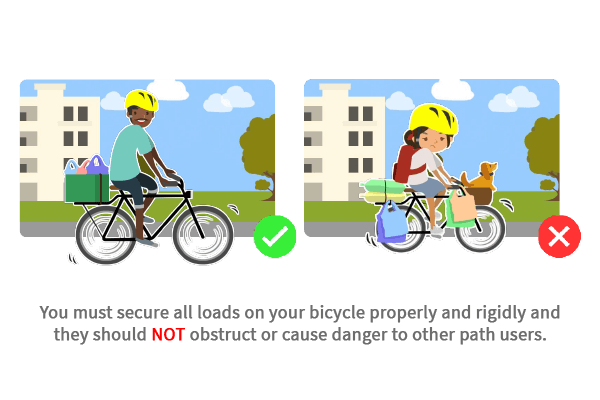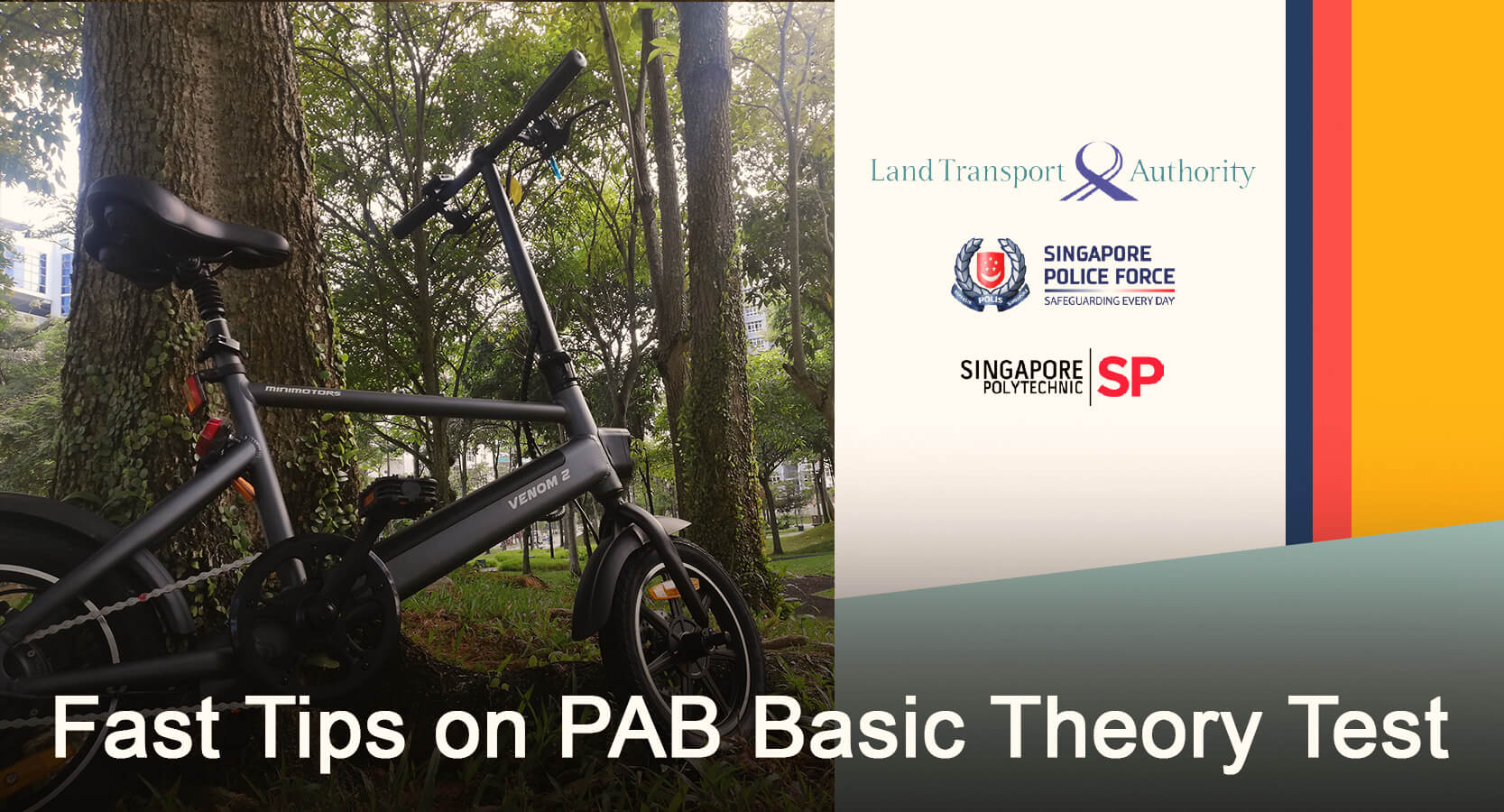A quick preparation Part B for a PAB Mandatory Theory Test coming at the end of June 2021.
This article will cover the last module that could be covered on your theory test.
We hope this will help you get started to pass your theory test.
Fast Tips on PAB Basic Theory Test | Part B
PAB Handling Skills

- Look forward rather than down. Avoid breaking suddenly as you may lose control. Braking gently when stopping.
- Do not swerve. Maintain control of your handlebars when signaling.
- Look out for oncoming path users behind you before turning.
- Inform path users using a hand signal. Ring your bell or call out if needed.
- Keep your shoulders relaxed and do not jerk the handlebars while riding at Low Speeds.
- Dismount and push your device if you are not confident of controlling your device. Brake gently while going downhill to control your speed.
Types of Paths, Signs, & Infrastructure
Types of Paths

- Footpaths don’t have markings or treatments.
- Only PMAs, bicycles, and non-motorized PMDs are allowed on footpaths. The speed limit on footpaths is 10km/h.
- Cycling Paths along the road are generally grey or red. The speed limit is 25km/h.
- Motorized PMDs (including e-scooters) and PABs are not allowed in School Zone.
- Only PMAs can be ridden in. Pedestrian–only zones which are marked by the “No Riding” sign and red triangle markings on the ground.
Types of Signs

- No Entry to Motorcycles and Pedal Cycles (including bicycle and PABs).
- Expressway Ahead – DON’T enter. Bicycles and PABs are prohibited on expressways.
- When you see the “Stay on Track” sign, stay on your path and keep left.
- When you see the “Shared Track” sign, means the path is shared with both riders and pedestrians.
Types of Infrastructures

- Pedestrian Overhead Bridges are not allowed on all pedestrian overhead bridges and their connecting ramps.
- Bridges with Wheeling ramps could assist you to push your device up easier.
- Don’t ride across overhead bridges.
Other Traffic Signal On Paths: Ground Markings

- Directional arrows on the lanes of the carriageway indicate the direction riders can move.
- Merging arrows indicate that two traffic lanes are merging into one traffic lane.
- Parallel broken white lines indicate the end of a minor junction as it joins with a major road.
- Dashed pedestrian crossing lines indicate a pedestrian crossing.
Rules & Regulations for PABs
PAB Riders Must Know

- Pass and obtain the PAB Theory Test Certificate before riding.
- PAB can be ridden only on Cycling paths and roads.
- Don’t reckless riding.
- Obey all traffic signals and rules.
- Follow instructions of enforcement officers and don’t obstruct.
- Wear Helmets. Secure all loads on your bicycle properly.
- Lights must be turned on between 7 p.m. to 7 a.m. for visibility.
- Don’t use mobile communication devices while riding.
- Ride in a single file during bus lane operation hours.
- If you are involved in an accident, you must stop to render assistance, provide your particulars and report the accident.
- Ride to the left edge of the road and obey all traffic signals and rules.
- Not allowed on expressways and road tunnels.
- Not tow another vehicle or be towed by another vehicle.
Dismount & Push Your PAB

There are a few locations where you cannot ride your PAB:
- Footpaths.
- Overhead bridges.
- Non-bicycle ramps bridges.
- Underpasses.
- “No Riding” signs locations.
- Pedestrian-only zone, and high pedestrian traffic areas.
- When passing through void decks and common corridors and spaces in HDB estates.
- At bus interchanges/terminals and train stations.
Navigating Off-Road Scenarios

- Ride at walking speed or dismount and push your PAB when you enter the high pedestrian traffic areas.
- Keep a safe distance and don’t tailgate.
- Gently alert that you intend to overtake them when you are about 5 to 10 m away. Overtaking when no one is approaching you.
- Don’t overtake others when approaching places such as pedestrian crossings, bends, and blind corners.
- Move to the side of the path to avoid obstructing other path users if you wish to stop riding.
Navigating On-Road Scenarios
Basic Steps to Ride on Roads

- Keep to the left, show your hand signal early before you make a turn.
- Show the right turn hand signal. Check for vehicles behind, then move right to the centre of the lane as you approach the junction.
- Don’t enter the bus bay and look out for the bus.
- Don’t squeeze between a stopped bus and the kerb when riding through bus stops without a bus bay.
- Keep at least 1.5m away from parked vehicles to prevent collisions with opening vehicle doors.
- Stay alert when you are in the driver’s blind spot. If you cannot see the driver’s face in the side mirror, the driver cannot see you.
Correct Way to Make Right Turn at a Junction

Steps to intend to make a right turn with a traffic light crossing:
- Check for vehicles behind you
- Then filter to the leftmost right turning lane.
- When approaching the junction and stay on the left side of the lane.
- Obey the traffic rules. Use green light to make the turn.
Good Practices & Code of Conduct

- Be alert and minimize distractions.
- Do not look at your handphone.
- Scan your surroundings, prevent potential dangers while riding.
- Don’t ride if you are tired or have consumed alcohol.
- Slow down or dismount and push at crowded areas.
- Slow down and prepare to stop when approaching intersections or blind corners.
- Be gracious. Gently alert others of your presence using your bell.
- Maintain a safe distance from other vehicles and pedestrians.
- Keep to the left unless overtaking.
Identification of Potential Hazards

a) Let’s not assume that others will do the correct action. Slow down to have time for the reaction.
- Path users may not aware of your presence alert, to give you the way.
- Don’t assume that drivers can see you or will give way to you.
- Not all vehicles will stop at crossings.
- Look out for blind spots where your vision is obstructed.
- Obstacles or the kerb when crossing the road may cause you to lose control of your device.
b) Be conscious of your riding conditions.
- While riding in heavy rain, increase your braking distance to perform a stop and slow down for safety.
- Turn on your lights for better visibility when dark.
- Perform pre-ride equipment checks.
What to Do in an Accident

If involved in an accident, the riders must do:
- Stop your device to provide assistance.
- Call for an ambulance if medical attention is needed. (Call 995)
- Remove the device to avoid causing an obstruction.
- Gather evidence of the accident.
- Exchange particulars (name, contact, residential address, and insurance information) with involved parties.
Tips: (ALWAYS Remember to tell the address first, then report the situation)
Oh great, you went through the basics of rules and code of conduct using PAB. This has covered- Fast Tips on PAB Basic Theory Test | Part B for PAB Riders. You are passionate about cycling. Would you reserve your theory test for $5?
-
- Out of StockSale! Select options
- E-Bikes (EN15194)
Scorpion Electric Bike | LTA Approved | Free Gift x6 | Free 1 Year Warranty [In Stock]
- $799.00 – $839.00
- Rated 4.86 out of 5
-
-
- Out of StockSale! Select options
- E-Bikes (EN15194)
Venom 2+ Electric Bike | LTA Approved | EN15194 | Safety Mark | Free Gift x6 | Free 1 Year Warranty [In Stock]
-
$1,490.00$1,090.00 - Rated 4.83 out of 5
-
-
- Out of StockSale! Select options
- E-Bikes (EN15194)
Venom 2 Electric Bike | LTA Approved | EN15194 | Safety Mark | Free Gift x6 | Free 1 Year Warranty
-
$1,090.00$888.00 - Rated 5.00 out of 5
-


![Scorpion Electric Bike | LTA Approved | Free Gift x6 | Free 1 Year Warranty [In Stock]](https://minimotors.sg/wp-content/uploads/2019/11/Scorpion-Electric-Bicycle-LTA-Approved-Orange-800x800.jpg)
![Scorpion Electric Bike | LTA Approved | Free Gift x6 | Free 1 Year Warranty [In Stock]](https://minimotors.sg/wp-content/uploads/2019/11/Scorpion-Electric-Bicycle-LTA-Approved--800x800.jpg)
![Scorpion Electric Bike | LTA Approved | Free Gift x6 | Free 1 Year Warranty [In Stock]](https://minimotors.sg/wp-content/uploads/2019/11/Scorpion-Electric-Bicycle-number-plate-800x800.jpg)
![Scorpion Electric Bike | LTA Approved | Free Gift x6 | Free 1 Year Warranty [In Stock]](https://minimotors.sg/wp-content/uploads/2019/11/Scorpion-Electric-Bicycle-4-color-800x800.jpg)
![Scorpion Electric Bike | LTA Approved | Free Gift x6 | Free 1 Year Warranty [In Stock]](https://minimotors.sg/wp-content/uploads/2019/11/Scorpion-Electric-Bicycle-800x800.jpg)
![Venom 2+ Electric Bike | LTA Approved | EN15194 | Safety Mark | Free Gift x6 | Free 1 Year Warranty [In Stock]](https://minimotors.sg/wp-content/uploads/2019/11/Venom_2-Grey-800x800.jpg)
![Venom 2+ Electric Bike | LTA Approved | EN15194 | Safety Mark | Free Gift x6 | Free 1 Year Warranty [In Stock]](https://minimotors.sg/wp-content/uploads/2019/11/Venom-22-800x800.jpg)
![Venom 2+ Electric Bike | LTA Approved | EN15194 | Safety Mark | Free Gift x6 | Free 1 Year Warranty [In Stock]](https://minimotors.sg/wp-content/uploads/2019/11/Venom-21-800x800.jpg)
![Venom 2+ Electric Bike | LTA Approved | EN15194 | Safety Mark | Free Gift x6 | Free 1 Year Warranty [In Stock]](https://minimotors.sg/wp-content/uploads/2019/11/Venom-23-800x800.jpg)
![Venom 2+ Electric Bike | LTA Approved | EN15194 | Safety Mark | Free Gift x6 | Free 1 Year Warranty [In Stock]](https://minimotors.sg/wp-content/uploads/2019/11/Venom_2-Orange-800x800.jpg)





